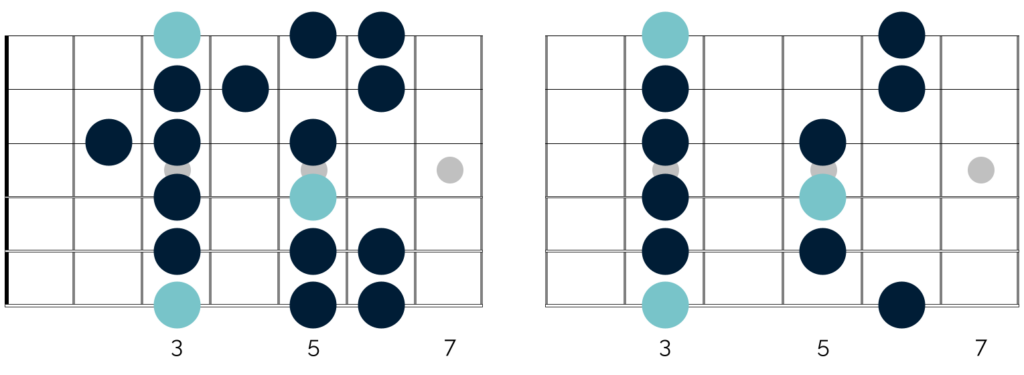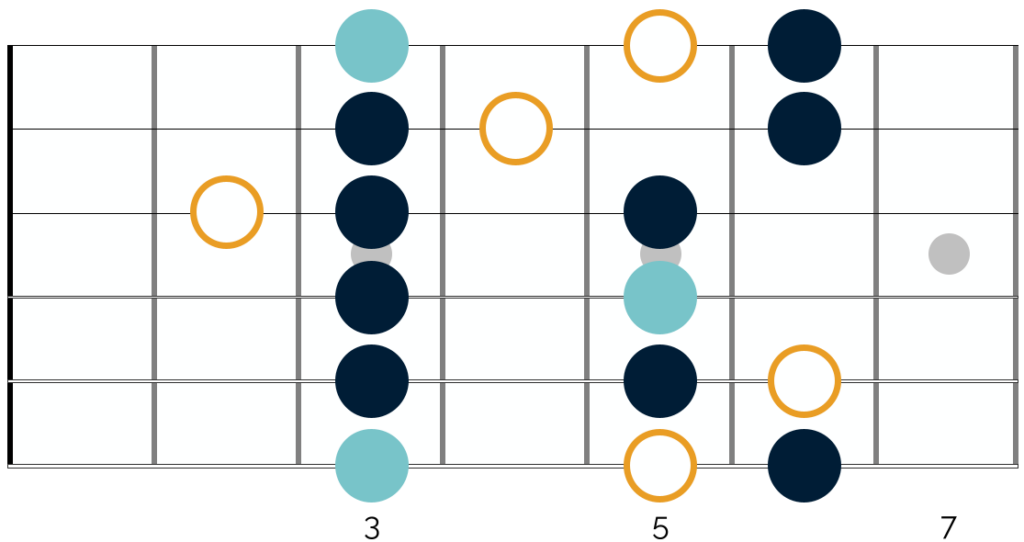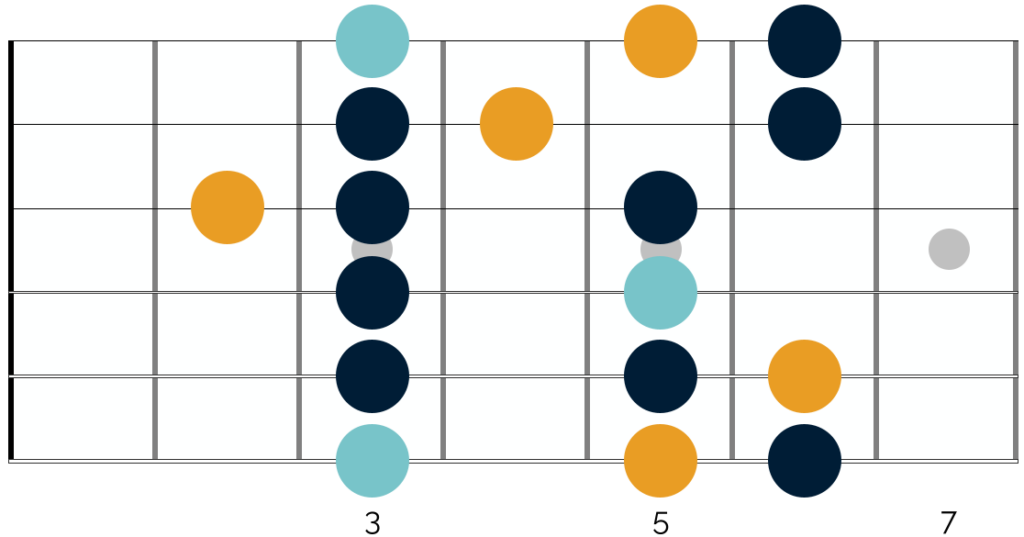Moving past the pentatonic scales and getting started on the modes is often a real challenge for guitarists.
In my opinion, there are two reasons for this:
The first of these is that to understand the modes and how they are constructed, you have to work through quite a lot of theory. To fully grasp the modes, you have to first understand intervals, how chords are created and the construction of the major scale.
You then need to navigate the unusual names of the modes and get comfortable with the fact that 7 different modes all utilise the exact same scale shapes.
This theory can be quite complicated, so if it is totally new to you, I would recommend heading over to my full course on the topic – Getting Started With The Modes – before continuing here.
Even once you appreciate that theory however, it can be complicated to use the modes in your playing. Knowing the modal scale shapes and understanding the theory behind how they are created doesn’t suddenly enable you to solo freely with them.
If you are in this position, then good news!
In this week’s quick win lesson we will look at how you can approach this challenge to start soloing confidently with all of the modal scales.
Specifically, we will break down the challenge of soloing with the modes into 3 easy steps. These will help you to start soloing confidently with the modes, whilst retaining an authentically bluesy feel in your playing.
So without further ado, let’s get into it!
Step 1 – Understand the modal ‘trick’
In my experience, the modes pose such a challenge for most players because they feel very different to the pentatonic scales. When you start using the modes, it is easy to feel like you are tackling a whole new and different type of scale.
Yet whilst it might feel like this is the case, it isn’t quite true.
In all of the modes of the major scale you will find a familiar shape of either the minor or major pentatonic scale ‘hidden’ within the mode.
If you are using a minor mode, you will find a shape from the minor pentatonic scale within each modal scale shape.
Conversely, if you are using a major mode, you will find a shape from the major pentatonic scale within each modal scale shape.
This is simply because all of the modal scales (apart from the largely theoretical Locrian mode) contain 5 intervals present in the pentatonic scales, in addition to 2 extra intervals.
For example, the minor pentatonic scale contains the following intervals:
1 b3 4 5 b7
The Aeolian scale contains all of these intervals, plus 2 additional intervals. So the intervals present within the Aeolian mode are as follows:
1 2 b3 4 5 b6 b7
As you can see, 5 of the intervals in the scale are shared. It is just that there are 2 extra intervals in the Aeolian mode which aren’t present in the minor pentatonic scale (highlighted above in yellow).
When discussed in these terms, this relationship can still be a little difficult to appreciate. However it becomes easier to understand when viewed on the fretboard.
I illustrate this from shortly after the 20 second mark in the video above, when I compare the first shapes of the G minor pentatonic scale and the G Aeolian mode:

When laid out side by side in this way, hopefully you can see the relationship between the two scales.
The Aeolian mode contains all of the notes of the minor pentatonic scale, plus 2 additional notes (which appear in both octaves of the scale).
We can illustrate this another way if we look at the first shape of the G Aeolian mode, with the notes that appear just in the modal scale shown in white:

As above, hopefully you can see the minor pentatonic scale ‘hidden’ within the broader modal shape.
This relationship is true for all of the modes, except for the locrian mode. This is a diminished mode and so doesn’t contain the 5th interval that is present in the minor mode.
However for any of the modes that you are actually likely to use in your playing, you can connect them up with either the minor or major pentatonic scales.
Luckily, the connection here is nice and straightforward – you will find the major pentatonic scale shapes within the shapes of the major modes and the minor pentatonic scale shapes within the shapes of the minor modes.
You can see this on the following summary table (I have excluded the Locrian mode, as it is a largely theorectical mode):
| Mode | Corresponding Pentatonic Scale |
| Ionian | Major pentatonic |
| Dorian | Minor pentatonic |
| Phrygian | Minor pentatonic |
| Lydian | Major pentatonic |
| Mixolydian | Major pentatonic |
| Aeolian | Minor pentatonic |
In this way, you can always find a familiar pentatonic scale shape within the modal scales, regardless of which mode you are playing.
Step 2 – Start with the minor pentatonic
The biggest mistake I observe in players learning the modes is that they leave all of their familiar licks and ideas behind.
They treat the modes as completely new scales, and then struggle to create licks and navigate across the scale effectively.
Appreciating the concept covered in the first step prevents this from happening. When you understand that all of your familiar pentatonic shapes are contained within the modes, you can take a pentatonic first approach.
In other words – rather than thinking about playing a new and different scale – you can think about playing the relevant pentatonic scale, and then enhancing it with the additional notes of the mode.
Let’s bring this to life by returning to the first shape of the G Aeolian mode:

Here, I have marked the notes that only appear in the Aeolian mode in yellow.
Now then, rather than thinking about a new scale, you are thinking about the minor pentatonic scale, in addition to these modal notes.
When you take this approach, you can use all of your ‘go-to’ minor pentatonic blues licks. This gives you a strong starting point, and you can then think about adding some of the specific Aeolian notes into your phrases after that.
As you might expect, the obvious benefit of this is that you don’t have to leave behind all of the licks and phrases you have worked so hard to create using pentatonic scales. This puts you into a strong starting position and prevents you from feeling lost or overwhelmed with the modal scales.
There are however two secondary benefits worth considering:
The first of these is that this approach actually helps you to bring out the sound of each specific mode. If all of the minor modes contain the notes of the minor pentatonic scale, and all of the major modes contain the notes of the major pentatonic scale, then each mode only has 2 differentiating notes.
These differentiating notes are what give the mode its flavour or colour. So by consciously targeting these notes as ‘modal notes’ alongside the pentatonic, you are able to bring out the specific sound of that mode with greater clarity.
For example, the 2 and b6 give the Aeolian mode its specific flavour. The same is true for the b2 and b6 in Phrygian or the 3 and b7 in Mixolydian.
Finally, taking a pentatonic lead approach ensures that your playing retains a distinctly bluesy flavour. The minor pentatonic scale defines the sound of the blues and so should remain at the centre of your approach, even when you begin using other scales.
Starting with the pentatonic and building from there ensures that the different flavours of each mode enhance your blues licks, rather than overwhelm them.
Step 3 – Play with intention
Once you begin to apply this idea in your playing, it is important to do so intentionally. Each mode that you use contains colour tones that you can use to add depth and variety to your playing.
It is important to note however, that you need to treat these notes with care. Let’s take the Dorian mode for example. This contains all of the notes of the minor pentatonic scale, in addition to a 2nd and 6th interval.
These additional notes define the sound of the scale, and can give it a jazzy and even latin feel. It is for this reason that the scale is widely used by Carlos Santana, and appears in songs like Evil Ways and Oye Como Va.
Of course, the musical context of these songs and the use of certain instruments like organs and percussion helps to create their latin feel.
However the fact that Santana targets the colour tones of the Dorian mode in his solos does a lot to define the character of his lead playing. Specifically, it makes it less bluesy and more latin sounding.
As you can hopefully see then, zoning in on the colour tones of a mode can totally change the sound of your playing.
If this is your intention, that’s wonderful! If however, you find the character of your lead playing shifting and you are not sure why, I would recommend taking a step back and assessing why this is the case.
It is most likely that you are doing one of the following 3 things in any given mode:
- Playing the colour tones too often
- Holding onto the colour tones for long periods of time
- Resolving phrases on the colour tones
If any of those points apply to you, then work on targeting the modal notes less frequently.
Conversely, if you are trying to increase the sound of a mode in your playing, then these 3 points will help you to achieve that aim.
Either option is fine – the most important thing is that you target the mode intentionally. This will ensure that you create the character that you want in your playing, and do so purposefully, rather than accidentally.
Closing thoughts
It takes time to introduce a new scale into your playing. If up to this point you have been largely focused on the pentatonic scales, then effectively using the modes poses a new and interesting challenge.
However, by following the steps laid out in this quick win lesson, you can break this challenge down into manageable chunks. This will help you to add new flavours into your playing whilst holding onto all of your ‘go-to’ licks and phrases.
If you have any questions on any of this material, just send me a message through your dashboard and I am always around and happy to help.
Otherwise, good luck trying this out – and I’ll see you next week for another quick win lesson! 😁
